England-South Africa Flights
-
Salaman, Peggy Louise
Peggy Louise Salaman 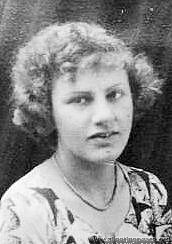 1935
1935b. 20 September 1910 (or possibly October 1907)
Peggy's brief moment in the spotlight came in November 1931. She and Gordon Store flew her D.H. Puss Moth 'The Good Hope', and two lion cubs, to Cape Town, in 5 and a half days, breaking Glen Kidston's record by 28 hours.
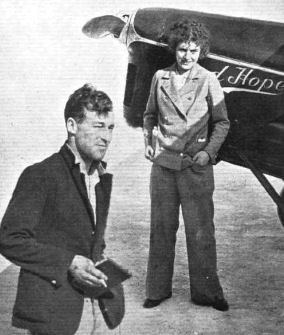
They gave her a celebration dinner at the Dorchester, at which she modestly pointed out that Gordon did "all the navigation, the chief part of the piloting, the forced landing [they missed an aerodrome and had to spend the night in 'dangerous country'] and for landing and taking off at the majority of the aerodromes", as well as looking after the engine. She did all the organisation and relieved Mr Store "when the flying was easy". Nevertheless, neither of them had more than about 20 hours sleep during the entire flight.
The lion cubs? She picked those up in Juba, [Southern Sudan, as you probably know] took them to Cape Town and then on to England. They appeared in the Christmas circus at Olympia and then went on the road with Bertram Mills's Circus. In October 1932 they were reported as being "sturdy young lions" who were "a picture of health". So that turned out well, then.
See a newsreel of her, and the lion cubs of course, here.
Their Cape Town record only stood for a few months, though; Jim Mollison managed it at the second attempt, in under 5 days, the following March.
She was, however, still (just) famous enough in May 1932 to get to meet Amelia Earhart at the American Embassy - more detailshere: Pioneering Women.
-
Scott, Charles William Anderson
Mr Charles William Anderson Scott 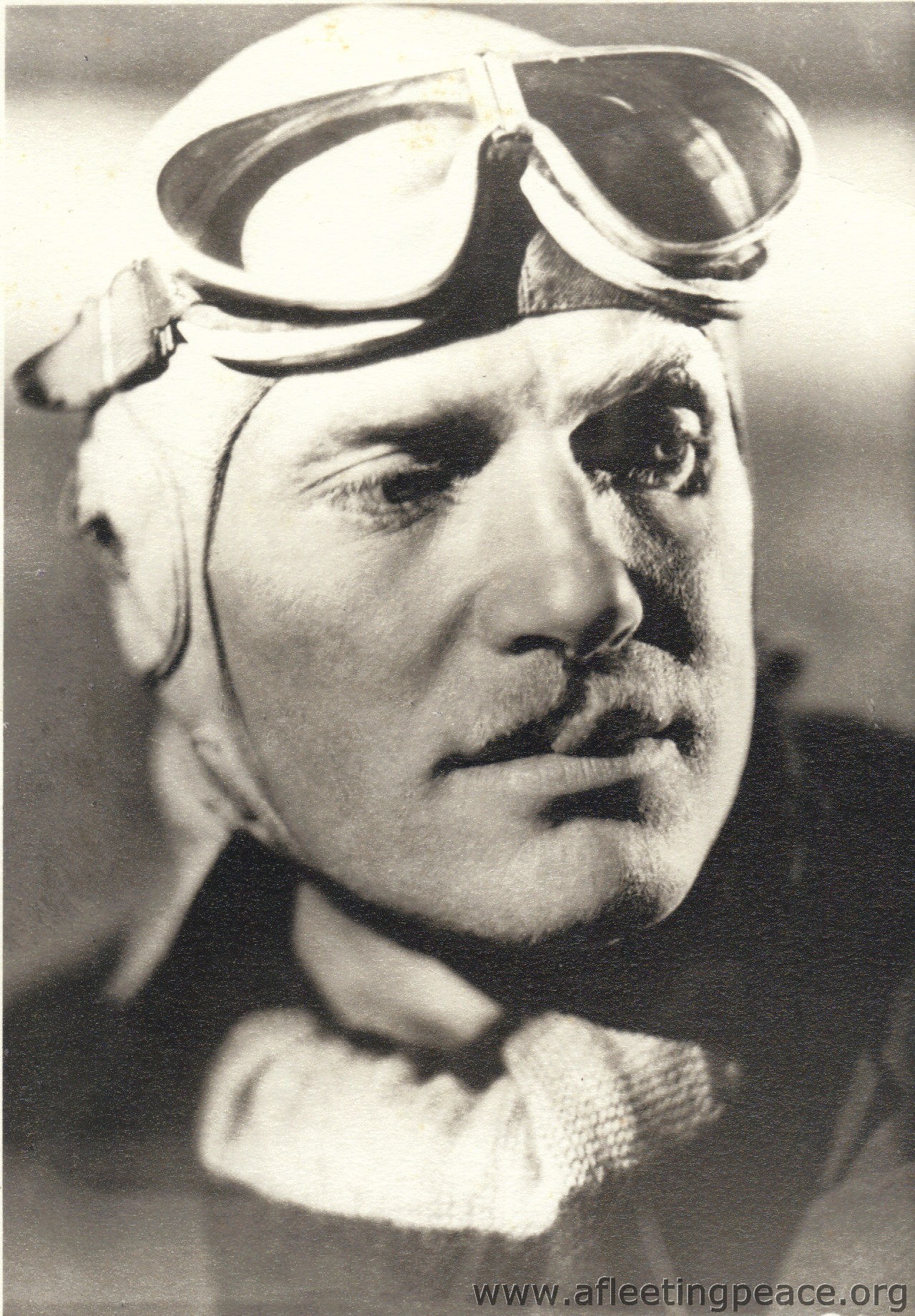
photo: 1934, aged 31
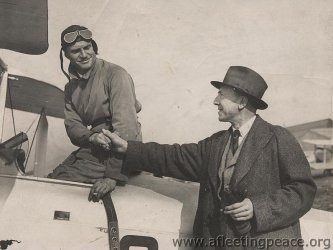 with his father Charles
with his father CharlesBorn 13thFebruary 1903 in London
One of the truly great aviators of the 1930s, establishing many long-distance records and winning some of the most important long-distance races of the period, but rather went to seed after that and shot himself after WWII. Scott wrote a book, and enterprisingly called it 'Scott's Book'.
"Scott is a splendidly-built six-footer, always in excellent condition. His other sporting recreations are golf and sailing."
"Charles Wiliam Anderson Scott, aviation editor of the 'News Chronicle', is the elder son of Mr Charles Kennedy Scott, the musician and conductor.
Educated at Westminster School, the future airman began his career as a sugar planter in Demerara, South America. The experience did not prove at all to his liking and he returned to England in 1922. Sailing was his passionate hobby - it still is - but as a youth trying to find his rightful career, flying did not occur to him until a friend suggested joining the Royal Air Force. Young Charles Scott sent in his application and thought little more about it until he found himself accepted and ordered to report to the Flying School at Duxford.
The Royal Air Force occupied the next four years of his life [he was heavyweight and light-heavyweight boxing champion whilst in the RAF] and in 1926 he was again wondering what was the next move when chance played the deciding game again. A sharp shower of rain sent him scurrying into Australia House for shelter with the result that he was bound for Australia not many weeks later.
There Scott became a pilot with Qantas Ltd., flying the mail routes in Western Queensland and acting as a flying instructor from 1927 to 1930. During that period he met the late Bert Hinkler, Mrs Mollison and the late Sir Charles Kingsford Smith and was inspired to break records.
Scott resigned his flying job in Queensland and came to England in 1931 determined to break the England-Australia record, despite accumulating financial troubles caused by the rising Australian rate of exchange.
He got there, reducing the record to 9 days 3 hours. That year he flew back again and made another record of 10 days 23 hours. Both flights beat Sir Charles Kingsford Smith's times.
In 1932 he attacked the England-Australia record for the second time and regained it with 8 days 20 hours.
The greatest adventure of his career was the magnificent flight in the Mildenhall-Melbourne air race of 1934 when he and the late Tom Campbell Black reached Melbourne in just under 3 days.

On September 17, Scott was married to Miss Greta Bremner, younger daughter of Mr and Mrs E L Bremner, of Melbourne, Victoria, Australia, only 12 days before the start of the Johannesburg air race."
- from the Celebration Dinner programme after the race (October 14th 1936 at Claridge's Hotel).
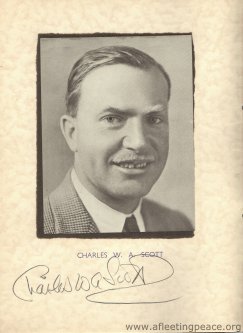
In 1936, his "Flying for All" Display embraced over 150 centres in the United Kingdom and Irish Free State, and was aimed particularly at "familiarising people with some of the cheap, easy-to-fly light aeroplanes available to-day".
Died 15th April 1946, in Germany, aged 43
.jpg)

p.s. The £10,000 MacRobertson first prize would, using average earnings, be worth about £2 million today.
-
Smith, Victor C
Victor C Smith  1936, aged 23
1936, aged 23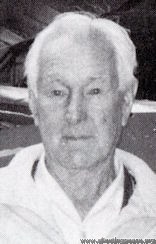 2000, aged 86
2000, aged 86Made several flights through Africa in record-breaking attempts, but his "pluck... exceeded his luck".
For example; in 1932, aged 19, he took off from Cape Town in a DH Moth, to try to break the record to London. He missed breaking the record by a few days, having been delayed by a 'run-in' with some fierce members of the Toureg tribe in the Sahara. He got out a cup of water and a packet of liver salts and drank the foaming liquid; such a man, they thought, must have supernatural powers, so they let him go.
Reaching London eventually, he then swapped the Moth for a Comper Swift and tried to fly back, but suffered engine failure; this time he had to walk 80 km through the Sahara. You'd think that would be it, but no: he found another aeroplane and continued south, only to run out of fuel just short of Cape Town.
In all, he made 21 forced landings during his flying career, all without serious injury. He wrote a book of his experiences, called 'Open Cockpit over Africa'.
In 1936, "Victor Smith was the most enthusiastic person at Portsmouth, and was obviously deeply in love with his Sparrowhawk". Aaaah.
Became a flying instructor after the race, then in WWII flew Beaufighters in Yugoslavia.
-
Spooner, Winifred Evelyn
Miss Winifred Evelyn Spooner
Royal Aero Club Certificate No. 8137 (11 Aug 1927)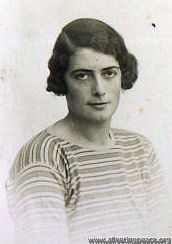 1927, aged 27
1927, aged 27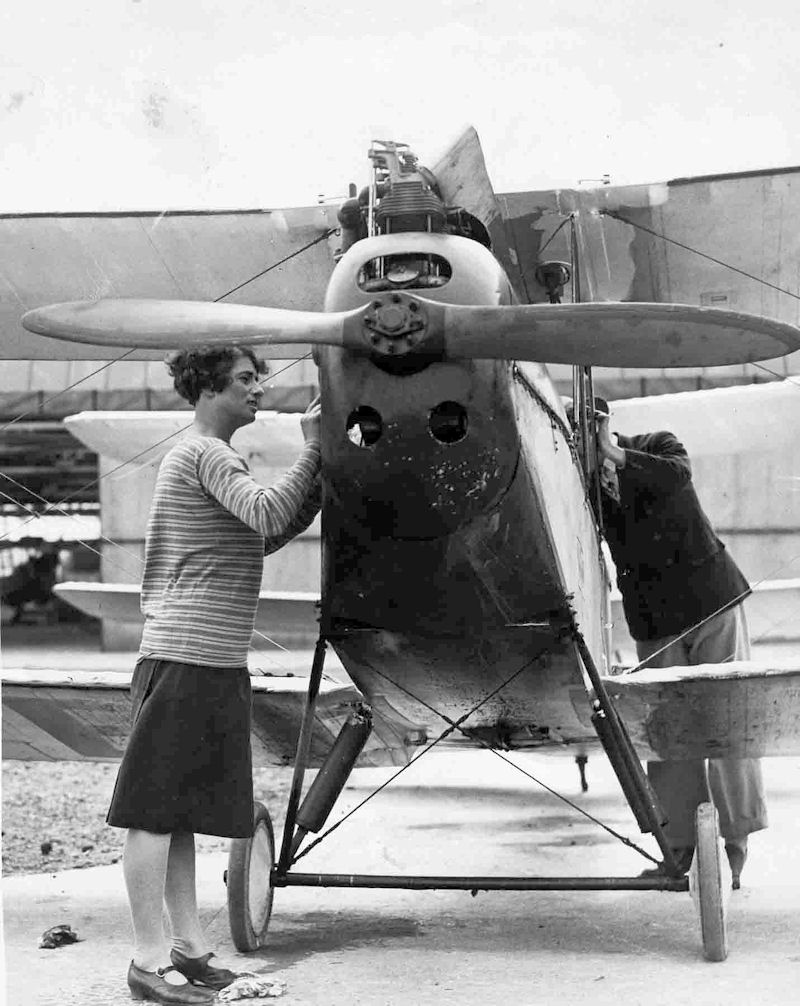
'Bad luck Wimpey' was one of the best-known women aviators of the time, and the one generally regarded as the best. She was awarded the International League of Aviation's Trophy for women aviators in 1929, and in 1930 Capt C D Barnard described her as 'the finest woman pilot in the world' (He went on to say that Lady Bailey was regarded as the 'second finest airwoman in the world', and we don't know what she thought about that...)
Learnt to fly in 1926 and took it 'more seriously than most' - in her first race in April 1928, she won the Suffolk Handicap (21 miles at 78mph), ahead of Neville Stack and four other male rivals; she won the 'heavy' category in the Round Europe Contest for Touring Aircraft in 1930 - covering 4,700 miles at 102mph, ("a very fine performance indeed", said The Times) and also competed in the Ladies event at Reading (May, 1931) - the other competitors were Amy Johnson, Grace Aitken, Pauline Gower, Dorothy Spicer, Susan Slade, Gabrielle Burr, Christina Young, and Fidelia Crossley - a historic gathering indeed.
Photo here
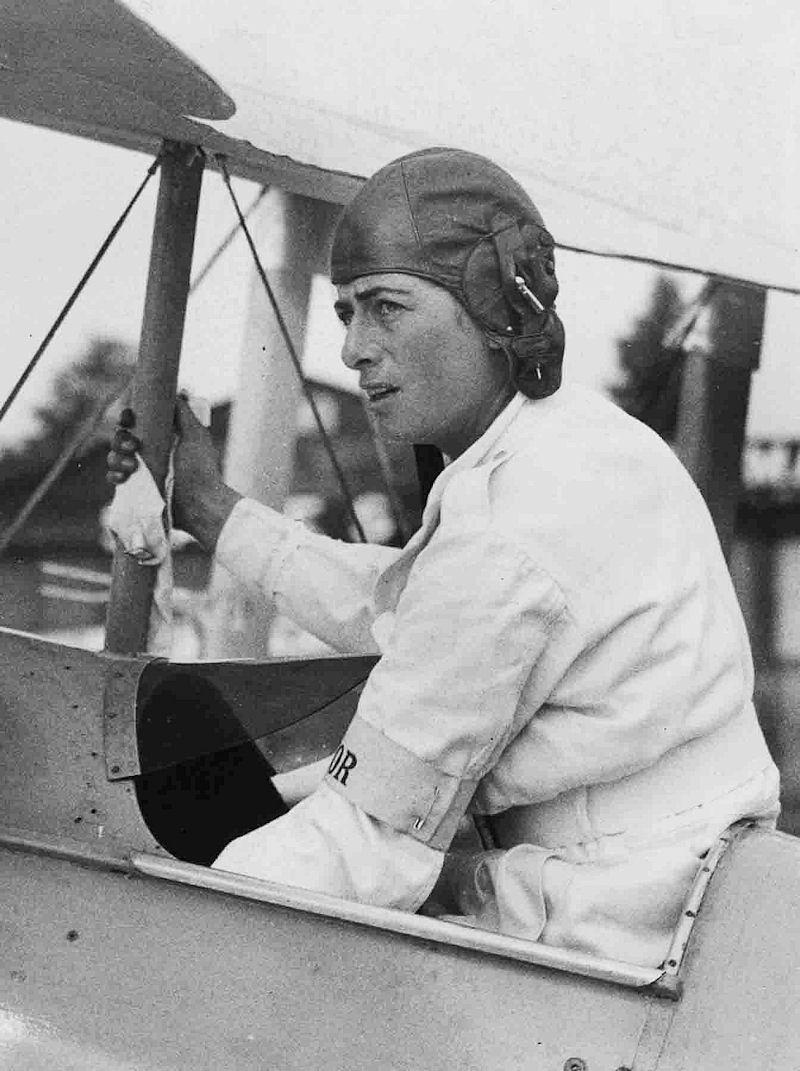
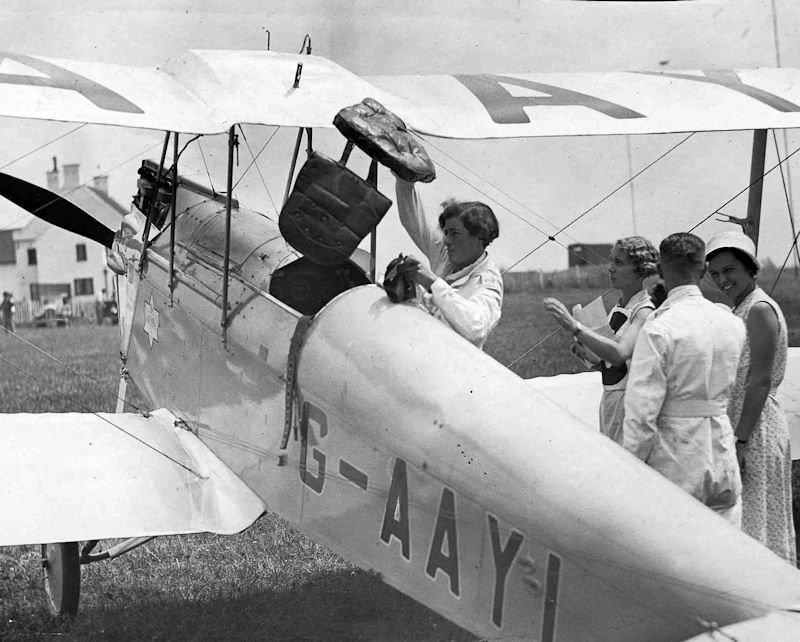
She soon took her 'B' (Commercial) Licence, and at one stage was the only professional woman pilot in the country.
In September 1927 her first flight abroad was to Venice to support the British Team in the Schneider Cup in Venice. Alan Butler (with Peter Hoare as passenger), and Hubert Broad, who took Maia Carberry, also went and, in case you were wondering, "Mrs. Carberry wore a pale blue leather flying helmet to match the colour of her Moth aeroplane."
She soon became regarded as 'one of the few women who matter in the air world'; in March 1928, when King Amanullah of Afghanistan was on a state visit to London, he inspected "the latest types of Imperial Airways passenger machines and a number of small Moth machines in private ownership. He carried on, through an interpreter, an animated conversation with Miss Winifred Brown, of Manchester, and Miss Spooner, of London, both of whom own and fly small two-seater machines."
In the 'Woman's World' section of the Inverness Courier of April 1928, this description of Winifred appeared: "[she] has not flown for very long, for it was only about three years ago that I knew her in Cologne, when she then drove, instead of an aeroplane, a two-seater car, through the crowded streets of Cologne, at a speed which most people would have been terrified to attempt. She was always, however, extremely cool and composed, and though her passengers were sometimes nervous she never seemed so. She was always very sporting, and played an excellent game of tennis. A good-looking, typically English girl, she made many friends among the British army in Cologne when doing voluntary work with the Y.M.C.A. there. [Winifred was with the 'Army of Occupation' in Germany at the time]"
She did have what she later described as her 'greatest air thrill' on Marlborough Common in May 1929; "she had been taking passengers up all day when, after one flight, she said she was not quite satisfied with the controls, and refused to take the next man until she had attended to the aeroplane. After doing so she started the propeller, and as she walked away from it the machine suddenly moved forward. Pluckily, Miss Spooner jumped and caught hold of the wing, her idea being to clamber into the cockpit and stop the engine. The machine quickly gathered speed, and she was dragged 40 or 50 yards [she later reckoned it was about 30 yards], when to the horror of the crowd the plane turned and buried its nose in the ground, hurling Miss Spooner some distance. She was unconscious. Doctors were sent for and she was taken to hospital. 'We thought she must have been killed,' an eye-witness told our representative."
She was taken to Savernake Hospital suffering from a sprained wrist, cuts, and slight concussion.
She does seem to have had quite a few run-ins with the local Constabulary; firstly in January 1929 for failing to keep her Alsatian dog under proper control (it had attacked another dog which "had no chance"), then in August 1929 for failing to produce a car driving licence (she said she had forgotten about it and flew to France the following day); then in 1931, she was fined £35 for leaving her motor car unattended and for failing to have lights on it. When she was told that she would be reported, she said: "I am used to it." A police-superintendent said there were no previous convictions recorded against her, as far as Reading was concerned. The Chairman then asked 'And none in the air? She replied 'There are no policemen in the air. That is why I like it.'"
I'm certainly sorry I missed her talk, given in April 1928 at Harrods in Brompton Road, on "Flying as a New Delight for Womankind". Later, in the early thirties, she wrote for "Good Housekeeping" on, of course, "Flying for Women", alongside such luminaries as John Galsworthy, Kate O'Brien, and Hugh Walpole.
.jpg)
September 1929 saw her accompanying NFS's chairman Freddie Guest (q.v.) to Nairobi, to inaugurate an air taxi service and give flying lessons. They took 3 aeroplanes with them, and flew them back (via South Africa) in February 1930.
She and E C T 'Cecil' Edwards tried to fly a Desoutter to Cape Town and back in December 1930, but this expedition ended up in a forced landing in the sea off southern Italy; Cecil and Winifred had to swim a couple of miles to shore.
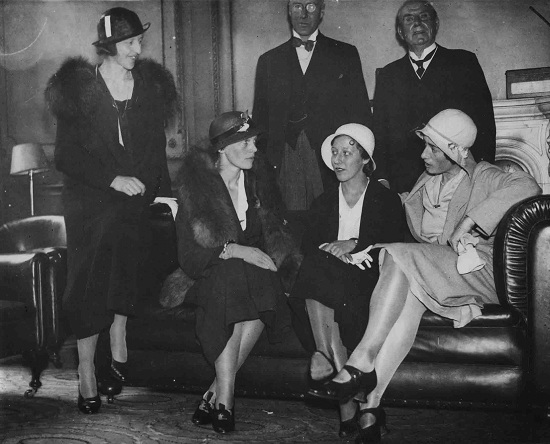
She regularly competed in the King's Cup - coming 3rd in 1928 - and was a guest at Amelia Earhart's reception at the Royal Aero Club in May 1932.
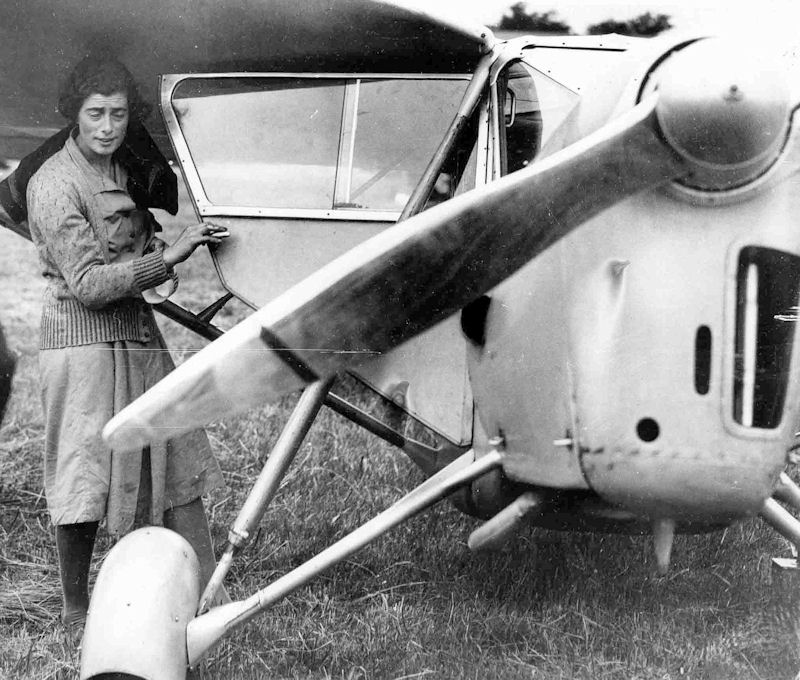
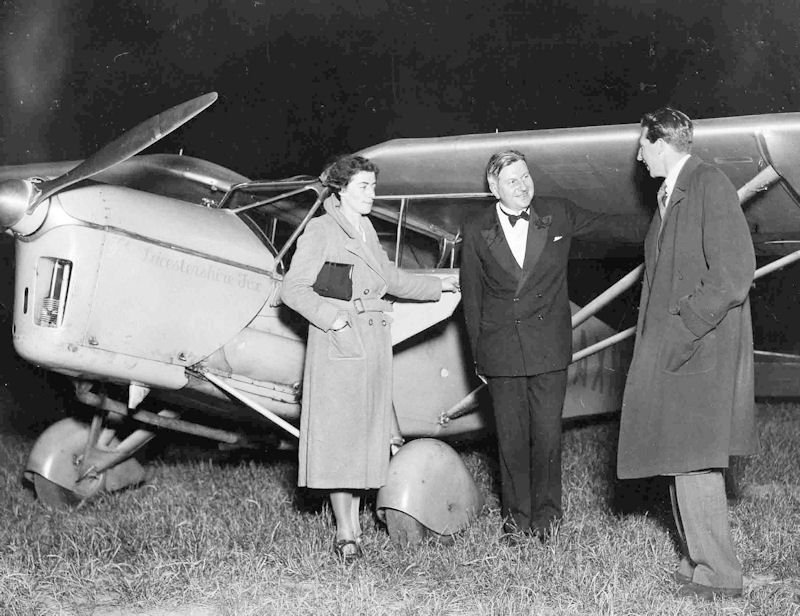
She was personal pilot to Leicestershire M.P. Lyndsey Everard from February 1931 - they are seen here with Nigel Norman.
And then, suddenly, on 13 January 1933, she was dead - not in an air crash, but as a result of a cold which rapidly worsened into pneumonia. Only few days before, in conversation with a friend, she had mentioned that her mother had died from influenza in 1918. "The deaths of both mother and daughter occurred with the same suddenness."
They are buried together in Hinton Parva: see http://www.earlyaviators.com/espoone5.htm
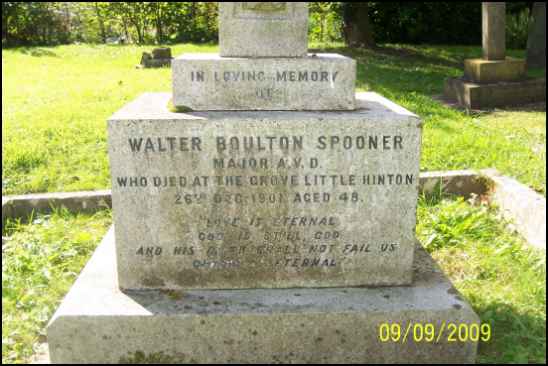
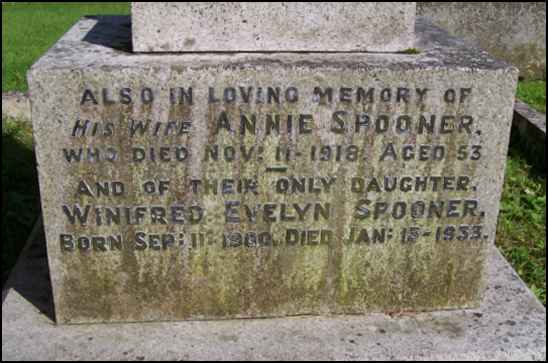
She left £1,357 0s 8d, and her brother, Capt. Frank Vivian Spooner, Indian Army (retd) was appointed administrator. She hadn't got round to writing a will.
There is a scholarship in her memory at Sherborne School for Girls.
"In the passing of Winifred Spooner the world has lost a great woman... she stood out as a woman of indomitable courage".
Winifred owned:
a 1926 DH.60 Moth (G-EBOT),
a 1928 DH.60G Gipsy Moth (G-AAAL, which she sold to Elise Battye);
a 1930 Desoutter IID (G-ABCU - this is the aeroplane she and E.C.T. Edwards ditched in the sea off Naples in December 1930), and later
a 1932 Breda 33 (G-ABXK), which was sold in Italy just 3 months before her death.
Winifred's brother Tony was chief flying instructor at the Montreal Flying Club in 1931. He was killed in March 1935 in Egypt when piloting a D.H. 84 Dragon, SU-ABI belonging to Misr Airwork, when it was caught up in a sandstorm and both engines failed.
-
Store, Gordon
Captain Gordon Store, MVO, OBE 
b. Kimberley, South Africa, on January 28, 1906.
In 1931 Gordon was co-pilot and navigator on the 19-year-old Peggy Salaman's record-breaking flight to South Africa in a De Havilland Puss Moth. They set off on Oct 30, 1931 from Lympne in Kent and five days, six hours and 40 minutes later they landed at the Cape, knocking more than a day off the record.
Young Gordon was educated at Kimberley Boys High School, at Mill Hill and Imperial College, London. He learned to fly at the De Havilland school and in 1926 was commissioned into the Reserve of Air Force Officers. After his flight with Peggy Salaman in 1931, Store remained in South Africa as a director of Aero Services, operating from a grass airfield at Wynburg.
Three years after setting this record Gordon Store joined Imperial Airways, serving on the airline's African and Empire routes before beginning a long association with the Atlantic in 1939, when he commanded one of the three crews which operated the first regular transatlantic services.After the war Store was recruited by Air Vice-Marshal Don Bennett of "Pathfinder" fame as operations manager of British South American Airways, which merged with BOAC in 1949. Store became a Douglas Stratocruiser captain.
d. October 4, aged 87.
-
Tribe, Mary du Caurroy (The Duchess of Bedford)
Mary du Caurroy Tribe, Duchess of Bedford
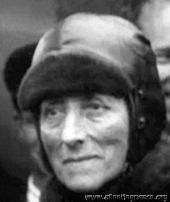
b. Mary du Caurroy Tribe in 1865 in Stockbridge Hants, the second daughter of the Rev. W H Tribe; he later became Archdeacon of Lahore and (after growing up in Sussex, where she and her elder sister Zoe were looked after by their uncle and aunt), she lived there for several years. It was in Lahore that she met, and married, Lord Herbrand Russell, who in 1888 became the 11th Duke of Bedford. She was probably best known as an aviator, but had several other strings to her bow; she was a member of the Society of Radiographers, and was "interested in natural history, especially ornithology". To prove this, she once shot 200 pheasants in a day and (although presumably not the same day) caught 18 salmon weighing 200lb.
Actually, she wrote scientific papers on ornithology, and was a member of the British Ornitholgists' Union.
She was deaf (I'm not sure if this was always true, or if it developed later on in life).
During WWI, Woburn Abbey was turned into a hospital and every morning the Duchess would "go on duty at 5 or 6am, and in her nurse's dress would assist at nearly every operation." The King was pleased to award her the 'Royal Red Cross, in recognition of her valuable nursing services', in Jan 1918.
Her personal pilots included C D Barnard, James Allen and (from 1934) R C Preston, but she herself learned to fly in 1933.
Dame Mary from 1928.
She owned:
a 1927 DH.60X Moth, G-EBRI;
the 1927 Fokker F.VIIa, G-EBTS, 'The Spider', in which she broke the England-Cape Town record in 1930;
a 1928 DH.60G Gipsy Moth (G-AAAO);
later she owned
a 1931 DH.80A Puss Moth, G-ABOC, later sold in Kenya,
a 1932 DH.60G Gipsy Moth, G-ABXR,
a 1933 GAL ST.4 Monospar 2 G-ACKT, registered in October, in which her personal pilot, James Bernard Allen, was killed in December 1933, and finally
a 1934 D.H.60G Moth G-ACUR in which she flew out over the North Sea in March 1937...
... and disappeared.
-
Tuckett, Frederick Roy
Frederick Roy Tuckett 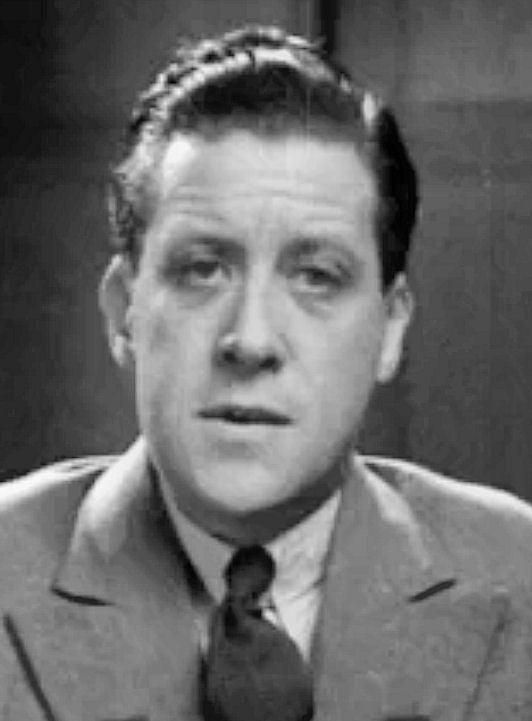
b. 10 Apr 1901 in Bushey, Herts. 5ft 11in tall, dark hair, blue eyes.
Flew his Moth solo to Cape Town in 1929-30 and returned in November 1930 on the 'Balmoral Castle' steamship to his home at 1 Hatton Gardens, London.
A year later, flew Miss Cook (a descendant of Charles Darwin) to study gorillas in Africa, and in 1935 flew the route of the 1934 MacRobertson Race to film it from the air.
In 1935, apparently (according to the Hull Daily Mail), "Everybody knows of Mr Roy Tuckett, the aerial film pioneer whose film, London - Melbourne," is attracting such large audiences at cinemas ail over the country, but few know that he was very nearly compelled to give up his career as airman through acute digestive trouble. In his own words: "A year ago I feared I could not carry on, could not eat a meal, could not even drink a cup tea without suffering agony from indigestion. Nothing tried seemed to bring me any relief. I had two X-rays, and my appendix was removed—all to no avail. I was on the point of abandoning my flight over the Australian Air Race Route when, as a last resource, I tried Maclean Brand Stomach Powder. To amazement the first dose brought instant relief, so I continued the treatment, carried the powder on my flight, and am completely cured."
In August 1935 he made a startling offer to Haile Selassie: "CABLE TO EMPEROR South African (sic) Airman Offers His Services Mr. F. Roy Tuckett. the South African airman-kinematographer, who filmed his solo Croydon-Capetown flight in 1929, and the London-Melbourne air race, yesterday cabled the Emperor of Abyssinia as follows:— Offer my services in defence of your country. Seven years' flying experience of light aircraft includes 50,000 miles cross-country flights over desert, or under tropical conditions, mainly in Africa. Would be willing to deliver aircraft to Addis Ababa." Interviewed by a Western Morning News representative, Mr. Tuckett explained the motive actuating his cabled offer. "I want to start a new life" he said."
While he was waiting for a reply, after a while WWII broke out. Roy joined, firstly, the Fleet Air Arm (1939-41) as a Lieutenant then, in September 1941, the Air Transport Auxiliary (ATA). He was Pilot No. 658.

see https://www.ata-ferry-pilots.org/
He later moved to Scotland, and saw something very strange in 1953: "The time was 10.45 a.m., and there was a dead calm... Happening to glance up, I noticed darkish cloud overhead from the base of which issued a long dark streak, which I took to be smoke, pointing down towards the sea at an angle of 45 degrees, and finishing a hundred or so feet above it... As I watched, I noticed it was shortening and being sucked into the cloud at the junction with which it became vapourised and was revolving rapidly. There was considerable turbulence of the cloud base. It continued to be drawn into the cloud until, within a matter of about three minutes, it had disappeared... I have been all over the world as an air pilot and have seen waterspouts and "dust devils" being sucked into the clouds from the desert, but I have never before witnessed a phenomenon quite like this."
He then wrote to the local paper; ". Weather freak Sir, —I was glad to see that other readers had observed similar phenomena in the sky on Monday. I suppose it must be ascribed to some particular weather trend. By the way, I have never been in the army. My flying experience was in my own plane in film work abroad.— Yours, &c., F. Roy Tuckett. West Balkello Cottage, Strathmartine, by Dundee, July 16, 1953."
d. 25 April 1961 in London
Roy owned the 1930 D.H60G Gipsy Moth G-AARW, later re-registered ZS-ABX.
Page 4 of 4

